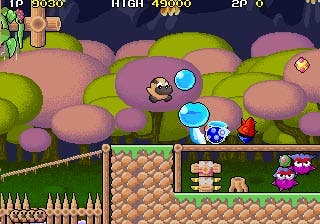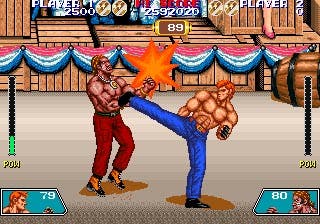Taito Legends 2
39 games for less than the price of one...
Our love-hate relationship with gaming's charming, fragmented, tormented, and often admirably naïve past continues. The worst thing is when the illusion and delusion of your memories are rudely shattered with the reality of crappy visuals, torturously exacting mechanics and rank playability. But every now and then your hallowed vision of a purer, simpler past is reaffirmed - especially when you stumble across something you missed out on first time around.
Taito Legends 2 confirms both sides of the argument several times over, featuring a staggering 39 coin-operated hits spanning 18 years - some of which you'll be all-too familiar with, and others that will have escaped the attention of all but the most ardent MAME freak. Riding on the back of the success of last year's 29-strong compilation, there's more than a whiff of barrels being scraped, but by virtue of the sheer weight of numbers there are still enough gems to warrant shelling out a mere £12.99 for it (Play's price - less than half the price of the mediocre Namco collection also released this week).
With an unlikely quantity of games to wade through, it'd be an exercise in masochism to expect us to review every single one, but here are some of the highlights in the key categories for you to check out - as well as some of the ones to avoid.
The platformers

Predictably, the Bubble Bobble clones are in evidence, but gaming historians will definitely want to check out Chack 'N Pop (from 1983), featuring some familiar gameplay mechanics (and some of the graphics) as the enduring Bub and Bob classic. Feeling like a cross between Bomberman (before its time), Bubble Bobble and Donkey Kong, you have to rescue an encaged heart and leg it to the exit while placing bombs near the enemies.
The Fairyland Story actually pre-dates the Bubble Bobble formula by a year, and unsurprisingly is a lot of fun - although lacks the two-player co-op fun, sadly. Essentially the difference is you control a character called Ptolemy, and get to cast spells at enemies, turn them into cakes and keep zapping them (or knock them down a level) to get rid of them. Hugely addictive, though. Bonze Adventure, meanwhile, comes across as a cheery lift of Ghosts N' Goblins, complete with the graveyard settings and a variety of pick-ups, and is certainly worth checking out if you're a fan of the Capcom platformers of the late 80s.
One of the best of the bunch, though, is Liquid Kids (1991) where you control Hipopo, throwing water bombs at enemies in a visually charming platformer that has more than a hint of Bubble Bobble influence, but unlike the clones has actually been fleshed out into a side-scrolling platformer that certainly looks good for its age. Elsewhere, real Bubble Bobble die-hards should check out Don Doko Don, which is basically the same single-screen enemy busting formula again, but with two hammer-wielding carpenters, Bob and Jim, instead.
The puzzlers

Top of our list is the all-time classic Puzzle Bobble 2 (a.k.a. Bust-A-Move 2), a game we were happy to spend £30 on ten years ago, and still one of our favourite games ever. Effectively three games in one; it's still enormous fun whether you're lining up bubbles in Puzzle mode, against the computer or (best of all) against a mate.
Next up, lost gem Camel Try is a cracking little game from 1989 where you tilt the maze to guide a ball to the goal, while avoiding the obstacles. The original Qix (from 1981) is a tad on the tough side (compared to, say, the superior Zolyx rip-off), but drawing lines to fill up 75 per cent of the screen is still one of those timeless concepts we'll never tire of.
Another game well worth a few minutes of your life is Raismais, a sort of futuristic Pac-Man-style maze game. Also, be sure to check out Crazy Balloon (1981), a proto Kururin where you have to guide a wobbling balloon to an exit while avoiding thorns. Indeed. Puchi Carat, meanwhile, mixes up Arkanoid with Puzzle Bobble with limited success - at least with the controls available to us here, so beware. Cleopatra Fortune, meanwhile, is a bit like Tetris Attack, only not quite as engaging for some reason. Next!
The beat-'em-ups

There's nothing much on offer here that really stands the test of time, but if you're determined to get your Renegade/Final Fight/Double Dragon/Streets of Rage fix with games you might not have come across before, then by all means check out Growl, which is a decent Renegade clone, albeit with almost identical gameplay and graphical style. Arabian Magic is more of the same, albeit with an Aladdin theme, Dungeon Magic is like an isometric Final Fight albeit with warriors at your disposal against goblins and orcs, Kuri Kinton is fairly standard side-scrolling brawler fodder from 1988, while Violence Fight is an incredibly basic one-on-one brawler that shows exactly why Street Fighter II was so badly needed in the genre.
Avoid rubbish like the awful side-scrolling hacker Naster, and the useless ninja hopping Legend of Kage - unless you have some fond memories you want to sully.
The shooters
With Space Invaders so hugely central to the Taito success story, it's hardly a surprise that various unnecessary rehashes make an appearance here. Space Invaders '91 is about as completist an addition as possible, offering little more than minor tweaks, while the DX version from a few years later at least offers the old-style versions along with the fairly pointless parody version that replaces the invaders with cutesy characters. Even less essential is Space Invaders '95, which spins the cute characters idea out to a full game, but ultimately misses the point entirely.
The numerous vertical and side-scrolling shooters on offer elsewhere in the package offer an interesting insight into how the genre developed over the 80s and 90s, but most come across as entirely generic me-too offerings these days. Things like Gun Frontier, Gekirindan and Grid Seeker look like 100 other bombastic, power-up heavy vertical shooters of the age, so only real die-hards need to worry about them.

Ray Storm sees Taito dabbling in 3D with reasonable success, but it's still the same old gameplay underneath. The side-scrollers, though, are more impressively represented by the likes of the long-forgotten Metal Black, featuring mammoth power-ups, zillions of enemies on screen at once and generally very impressive visuals for their era. In addition, the appearance of Darius Gaiden and G-Darius will have one or two of the shooter die-hards in a froth. The latter even tries its hand at 3D backdrops and enemies, with a fair degree of success, but sticks to the tried and trusted formula.
Insector X is a basic but functional cutesy side-scrolling shooter (a rarity in itself), and Syvalion's weaving, twisty-turny dragon-breath-shooter action tries to do something a little different, but like so many of these filler titles, the gameplay gets pretty tired within a few minutes. You'll almost certainly want to avoid things like Balloon Bomber, Frontline, Wild Western, Ki Ki Kai Kai and Elevator Action Returns unless you're really desperate, while even the classic Lunar Rescue doesn't bear more than a few goes before you'll want to move on - but for the money you won't mind too much.
The rest
Not fitting into any of the main categories, there's always the hideous collision detection nightmare that is Alpine Ski to check out (think Horace Goes Skiing, but worse), while Football Champ is utterly worthless, almost entirely unplayable and only worth a look to admire the 'tackles' you can pull off.
As a package, there are perhaps only a handful of genuine must-have titles among the 39 (Puzzle Bobble 2, Camel Try, Chack 'N Pop, and - at a push - Liquid Kids, the Bubble Bobble clones, Ray Storm and the Darius titles). However, it's all but impossible to make an objective assessment that takes into account everyone's hugely varying tastes. What's definitely unarguable, though, that this particular package has much better presentation than the last one, with all games sorted into chronological order (a small but valuable point), and various useful options that make the experience far better than most retro collections. Nice one, Taito.
With so many of Taito's best titles already accounted for in the first set, it's to be expected that this second volume ends up feeling like a completist's collection of me-too titles with few stand out offerings to get worked up about. Even so, the standard's generally pretty high and for the paltry asking price we're certainly not complaining one bit about the odd duff offering. If only more publishers were prepared to trawl their archives so exhaustively - and offer them at such a tempting price.

